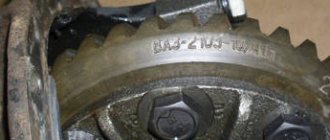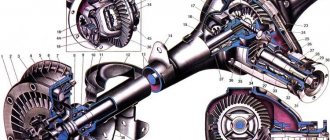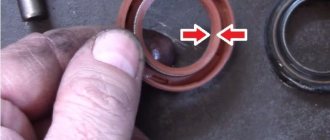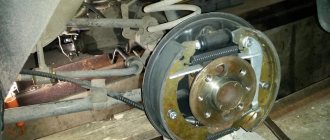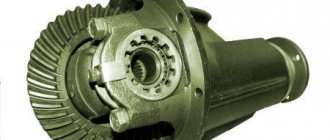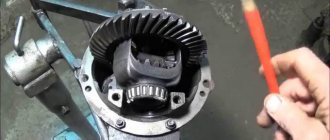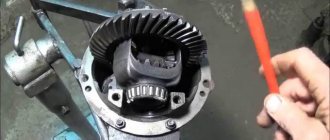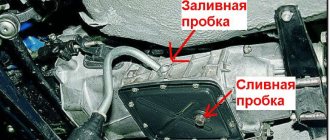27.01.2020
| (Votes: 1, Rating: 5) |
Issues discussed in the material:
- Why do you need oil in the gearbox?
- When to change the oil in the gearbox
- What kind of oil to pour into the gearbox
- Preparing to change the oil in the axle gearbox
- How to change the oil in the gearbox
- The opinion of experienced people about changing the oil in the gearbox
Changing the oil in the gearbox prevents increased friction of the elements, which occurs as its lubricating properties are lost. The gearbox is installed on the front axle of front-wheel drive cars (in this case, it is integrated into the gearbox), on the rear axle of rear-wheel drive cars, and on both axles in the case of all-wheel drive cars. It is thanks to this unit that torque is received from the crankshaft and its subsequent transmission to the center differential.
Since the torque is transmitted by the gearbox using toothed gears, it is they that suffer wear and tear over time. To prevent it and protect your car from breakdown, it is necessary to promptly change the transmission oil in this unit. We will talk about how to replace the lubricant in the gearbox in this article.
When to change the oil in the gearbox
When to change the oil in an automatic transmission gearbox? It is impossible to give an exact answer to this question. Typically, the lubricant is changed to a new one when servicing the transmission, when other working fluids are also added. Maintenance of the box should be performed every 45,000 kilometers (or every 60,000), that is, once every two years.
However, the gearbox oil should be changed more often if the machine is used intensively, as in the following cases:
- you are transporting heavy cargo, towing trailers or cars on a cable;
- the car is used in difficult conditions, for example, you drive off-road, in deep snow;
- drive in the city, often stuck in traffic jams.
If you have a new car, then after studying the operating instructions, you can find out that the manufacturer recommends performing the first oil change in the engine gearbox after 1,000–2,000 kilometers. After all, at this time, all the mechanisms of the car are rubbing against each other, which means that during this period the friction will be increased and a large number of wear products will begin to form.
If you do not change the oil regularly, it will lose viscosity. Then oxidation processes will begin due to the fact that hot air penetrates the depressurized system. All this will lead to decomposition of the working fluid, and it will no longer properly lubricate the parts. As a result, the gears will wear out and the gearbox will begin to overheat.
The influence of harmful factors on the rear axle of the car
A decrease in the amount of lubricant may be due to a deterioration in its technical characteristics, leading to a change in the viscosity index. Also, the level of consumables may decrease due to normal leaks that occur due to increased loads.
The appearance of gray dust is a sign of worn parts. The outer layer of spare parts wears off over time and precipitates. Once in the car oil, the sediment begins to circulate throughout the lubricant complex. If it ends up on an important part, its holes may become partially blocked. This may cause damage. If this problem is detected, fresh lubricant should be poured into the gearbox immediately. If you find metal particles or shavings in your car oil, it means you need to overhaul the engine and completely replace damaged parts.
What kind of oil to pour into the gearbox
When changing the oil, you should choose the standard transmission fluid recommended by the car manufacturer in the operating instructions for your car. In cases where you don’t have it on hand and you don’t know exactly what kind of lubricant you can use, you should take into account the API classification, as well as viscosity.
Most automakers recommend changing gearbox oil on new cars using GL-4 or GL-5 gear oil. These lubricants contain special additives that prevent scuffing from forming. How to determine what viscosity should be? In this matter, the climatic conditions in which the car is operated should be taken into account.
To change the oil in the transmission, it is recommended to use all-season lubricant, because no driver will fill in new operating fluid every season. All-season lubricants will have double numbering, for example, 75W-90. In this marking, 75 means viscosity at sub-zero temperatures, 90 viscosity in the warm season. If you need a working fluid that will withstand severe frosts, then choose oils marked with a lower first number. This lubricant will maintain viscosity even at low temperatures. For example, 70W is suitable for operation at 55 °C below zero, 75W at -40 °C, 80W at -26 °C.
How much fluid will it take to replace? If you have a front- or rear-wheel drive passenger car, 1-2 liters of lubricant will be enough. When the car is all-wheel drive, with two crankcases, it is better to purchase 3 liters or even more. To change the lubricant in a utility vehicle, you will need 10–15 liters of oil. Experts recommend always having 1 liter of liquid in reserve, because there is a high probability that you will need to flush the mechanism.
Performance characteristics
The API specification is taken as a basis. The division of oil liquids into categories occurs in this way.
| API category | Compound | Application |
| GL-1 | Mineral water without additives | |
| GL-2 | Products containing fatty compounds | Industrial mechanisms, gearboxes of conveyors, machine tools, production machines |
| GL-3 | Added anti-wear components | Manual gearboxes, drive axles, truck gearboxes |
| GL-4 | Added anti-seize components. | Manual gearboxes, drive axles, truck gearboxes |
| GL-5 | Complete list of protective additives | Gearboxes of passenger cars of mechanical and automatic type. |
Preparing to change the oil in the axle gearbox
If you plan to change the oil in the gearbox and transfer case yourself, adhere to the following rules:
- The machine must be secured securely. Put it on the handbrake; you should also put stoppers under the wheels.
- The transmission must be warmed up before you begin the replacement. When doing this, make sure that the gearbox is not hot. Be careful not to get the lubricant on your skin, otherwise you may get burned.
- You should change into old clothes in which you will be comfortable working. You should not wear synthetic clothing, because if it catches fire, it will stick to your skin.
- It is necessary to wear special protection so that the lubricant does not get into the eyes, nose and mouth, otherwise a burn to the mucous membranes will occur.
What is needed to change the oil in the steering gear:
- wrenches, the set should include box, open-end, and hex wrenches;
- a set of screwdrivers, you will need flat, Phillips, and Torx screwdrivers;
- WD-40. This composition will be needed to clean the screws and plug;
- container into which you will drain the old grease. Its volume should be slightly larger than the amount of working fluid in the mechanism;
- a syringe, as well as a hose, with the help of which the oil in the gearbox will be changed. Instead, you can use a hose of sufficient length and a funnel;
- a lift or inspection pit where you will perform the replacement.
First of all, you should prepare and then check the level of the working fluid. Moreover, this will have to be done without using a probe. Checking is done using the filler hole. Ideally, the lubricant level should be 0.2–0.5 cm lower than the hole. It is recommended to make a probe yourself; it can be used for testing. Also pay attention to the shade of the lubricant and how thick it is. What color of the working fluid can be:
- the lubricant is clean, its shade is exactly the same as that of new oil or a little darker. In this case, replacement is not necessary, since the working fluid has not deteriorated;
- the oil is dark and transparent. There are no foreign inclusions. What to do in this case? If the time has come, then you should change the oil in the gearbox, but if not, then you can replace it later;
We recommend
“Synthetics or semi-synthetics: understanding the composition of oils” Read more
- the lubricant is darkened and cloudy, microparticles of dirt and metal powder can be seen. The replacement should be carried out even if the deadline has not yet come. It is also recommended to wash the mechanism;
- the oil thickened and darkened. You can see metal shavings. Changing the lubricant is mandatory. Moreover, it is also necessary to diagnose the mechanism and possibly repair it. These procedures must be performed in a specialized car service center.
Recommended oil brands for wave gears
The designation of industrial oils consists of four characters, each of which means: the first
(I) - industrial, second
- belonging to the group according to purpose (G - for hydraulic systems, T - heavily loaded components),
third -
belonging to the group according to performance properties (A - oil without additives, C - oil with antioxidant, anti-corrosion and anti-wear additives, D - oil with antioxidant, anti-corrosion, anti-wear and extreme pressure additives),
fourth
(number) - kinematic viscosity class.
From grease lubricants
the most commonly used are CIATIM-201, Litol-24, Uniol-2 (Table 19.40).
Permissible immersion levels of spur gear
into the oil bath (Fig. 8.1): hm(2m…0.25d2). Here m is the engagement module. The smallest depth is considered to be equal to two engagement modules, but not less than 10 mm. The maximum permissible immersion depth depends on the peripheral speed of the wheel. The slower the wheel rotates, the greater the depth it can be immersed.
It is believed that in two-stage chat
At a low-speed stage card speed of v 1 m/s, it is sufficient to immerse only the low-speed stage wheel in oil. At v
when the shafts are located in a horizontal plane, the wheels of the high-speed and low-speed stages are immersed in oil (Fig. 8.2, a).
When the shafts are located in a vertical plane, the gear and wheel located in the lower part of the housing are immersed in oil (Fig. 8.2,
b).
If the depth of immersion of the wheel turns out to be excessive, then reduce the oil level and install a special lubricating wheel
1
(Fig. 8.2, c).
In bevel or bevel-helical gearboxes
the full width of the bevel wheel must be immersed in the oil bath b
crown
worm gear parts into oil
accepted: with the worm positioned at the bottom (Fig. 8.3, a) h M
= (0.1... 0.5)da1;
at the top (Fig. 8.3, b) h M
=
2t
...
0.25 d 2 .
However, with frequent switching on and short-term operating mode (start-stop-start), gear lubrication is insufficient. To avoid this, the oil level is raised to the engagement level.
If it is important to reduce heat generation and power loss in a worm gear (for example, at a high speed of rotation of the worm and long-term operation of the gear), the oil level in the housing is lowered (Fig. 8.3, c)
To lubricate the gearing, sprinklers 1 are installed on the worm (Fig. 8.3, c, d). In this case, oil is poured to the center of the lower rolling body of the bearing.
Gearbox wheel immersion standards
the same as for gear wheels.
between the bottom of the housing and the outer surface of the wheels or worm for all types of gearboxes and gearboxes the following is taken:
where a
defined earlier by formula (3.5).
How to change the oil in the gearbox
The first step to start changing the oil is to warm up the gearbox. Motorists with extensive experience advise driving about 5–10 kilometers. Then you need to park the car and get to work.
1. Drain the used oil
How to change the oil in the front gearbox? To do this, remove the crankcase protection. All bolts must be washed and then applied with WD-40. The gearbox also needs to be cleaned of dirt and corrosion. Corks can also be treated with WD-40. The fact is that most often they turn sour, so you should be careful when unscrewing them. Otherwise you will break the thread.
It is necessary to place a large container under the drain hole into which the liquid will be drained. Now you can unscrew the drain plug. As soon as the lubricant begins to flow out, unscrew the filler cap. Now you need to wait until all the liquid has drained out.
2. Wash the gearbox
Sometimes it is better to use a special cleaning agent for cleaning. However, oil is most often used for this. How to wash:
- We fill the gearbox with lubricant through the filler hole. This can be done using a syringe to which a hose of the required length is connected. The hose should be chosen so that it fits tightly on the syringe and passes into the filler hole. Lubricant volume is 70–80% of normal.
- Close the filler hole. Now you need to drive your car along the highway for 15–20 kilometers to break in the mechanism. Running in means smooth movement, no need to suddenly switch gears.
- Next, you should remove the liquid; how to drain it was described in the first paragraph.
- We study the drained lubricant, pay attention to its color and thickness. If necessary, wash again.
We recommend
“Semi-synthetic oil: description and composition” More details
3. We replace the oil in the gearbox with a new one
Filling is performed using the same technology as described earlier. To find out how much fluid is needed, read the car's operating instructions. Typically, the lubricant level should reach the bottom mark of the filler hole or be slightly lower. After this, carefully tighten the filler plug. Note! If the plug is not tightened properly, dirt will get inside the mechanism.
When the replacement is made, you should run the car in for 2-3 days. After this time, the lubrication must be checked. If it is in normal condition, then you did everything right.
If you do not change the oil in the gearbox in a timely manner, the mechanism will quickly fail, and driving the car will be unsafe, because a malfunction of the unit leads to the risk of an accident.
The opinion of experienced people about changing the oil in the gearbox
- Does the manufacturer recommend changing it every 100 thousand? Repair professionals recommend every 80 thousand. “I changed the oil in the rear axle gearbox at a car service after 100,000 km, as recommended by the car manufacturer. However, specialists at the service station advised doing this every 80,000 km. I trust these guys, they never let me down. I don’t recommend changing the lubricant in private auto repair shops, because no one can guarantee that such a mechanic knows how much fluid to fill.”
- Do you need to change the oil in the gearbox? Stop by the pharmacy first
“I drove 83,000 km, drove the car for 6 years. When the time came, I changed the oil in the rear gearbox with my own hands. In total, approximately 550 ml of lubricant was required. I filled it from a four-liter canister, so I can’t say the exact volume.The replacement was carried out on a summer cottage; there was no overpass or lift. I placed the car on stands (17 cm high). Filling with lubricant is the simplest procedure, the cost of changing the oil in the gearbox is minimal, because the cost of lubricant is low. And you don’t need to pay for the work, because I did everything myself.
Don't know how to add liquid? Take Janet's syringe. We put a flexible nozzle on it, about 20 cm long. The syringe contains 160 ml, I filled about three and a half syringes.”
- For three-liter models, the transfer case is in a different place
“If the car has a 3-liter engine, then the transfer case will be located next to the right front wheel. In this case, it will not be easy to get to the filler bolt. The automaker made an o on the head of the filler bolt to make it easier to navigate when replacing. I carried out the replacement after first studying the book from the publishing house “Third Rome”; if desired, you can download it, since it is freely available.”We recommend
“Do I need to change the oil after winter: all the pros and cons” Read more
- If the oil in the gearbox has not been changed, carefully fill in a new one
“A friend has a VAZ 4, no one has ever changed the lubricant in the gearbox, but there was no buzzing in the bridge. When I decided to change the old fluid, it was thick, like grease. After the replacement, he drove 2,000 km, and the gearbox began to hum. At the car service center, the guys said that in such cases, when no one has ever filled in new lubricant, the replacement should be carried out in several stages: first, drain a quarter, add new lubricant. And how he did it: he removed all the dirt that had gotten into every crack and crevice with new oil. And all the holes were exposed again.” - Do not change the oil in the gearbox “when it’s cold.”
How to replace it: loosen the drain nut, tighten it. Then you need to drive the car for 10–15 km, after which remove the lubricant. The heated liquid will drain faster. After that, inspect the filler plug. It needs to be checked in advance; perhaps it is stuck and unscrewing it will be problematic.”
The attractive qualities of mineral water and why semi-synthetics are better than others
The main advantage of mineral oil is its affordable cost. Due to the fact that it contains virtually no additives, the most attractive price for the end user is achieved.
In addition, the mineral oil poured into the bridge has sufficient viscosity so as not to penetrate the seals. The change in viscosity indicators with sudden temperature changes is insignificant.
The golden mean is semi-synthetics. It is not as expensive as fully synthetic axle oil, but at the same time it protects moving parts of the units more effectively than mineral oil.
It is important to change the oil on time, since without it metal shavings will accumulate inside. Ultimately, this may cause the mechanism to jam.
The video demonstrates the characteristics of domestic axle oil TAD-17:

